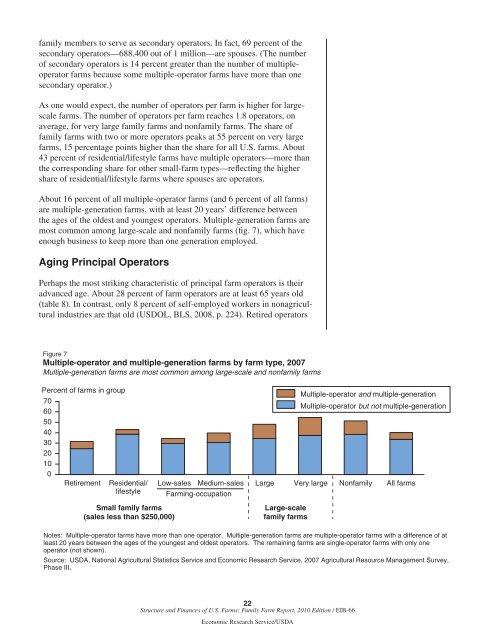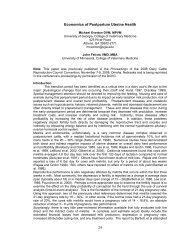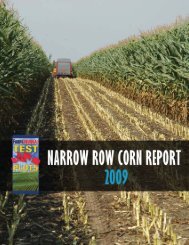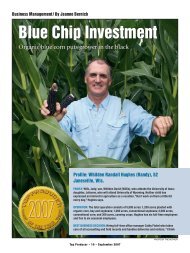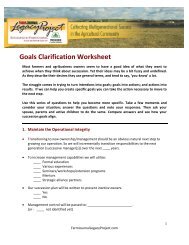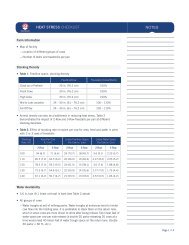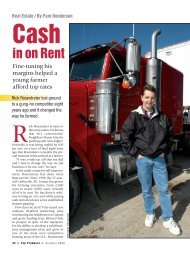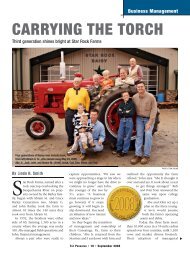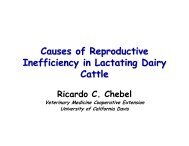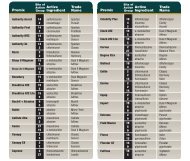Structure and Finances of U.S. Farms: Family Farm Report ... - AgWeb
Structure and Finances of U.S. Farms: Family Farm Report ... - AgWeb
Structure and Finances of U.S. Farms: Family Farm Report ... - AgWeb
You also want an ePaper? Increase the reach of your titles
YUMPU automatically turns print PDFs into web optimized ePapers that Google loves.
family members to serve as secondary operators. In fact, 69 percent <strong>of</strong> thesecondary operators—688,400 out <strong>of</strong> 1 million—are spouses. (The number<strong>of</strong> secondary operators is 14 percent greater than the number <strong>of</strong> multipleoperatorfarms because some multiple-operator farms have more than onesecondary operator.)As one would expect, the number <strong>of</strong> operators per farm is higher for largescalefarms. The number <strong>of</strong> operators per farm reaches 1.8 operators, onaverage, for very large family farms <strong>and</strong> nonfamily farms. The share <strong>of</strong>family farms with two or more operators peaks at 55 percent on very largefarms, 15 percentage points higher than the share for all U.S. farms. About43 percent <strong>of</strong> residential/lifestyle farms have multiple operators—more thanthe corresponding share for other small-farm types—reflecting the highershare <strong>of</strong> residential/lifestyle farms where spouses are operators.About 16 percent <strong>of</strong> all multiple-operator farms (<strong>and</strong> 6 percent <strong>of</strong> all farms)are multiple-generation farms, with at least 20 years’ difference betweenthe ages <strong>of</strong> the oldest <strong>and</strong> youngest operators. Multiple-generation farms aremost common among large-scale <strong>and</strong> nonfamily farms (fig. 7), which haveenough business to keep more than one generation employed.Aging Principal OperatorsPerhaps the most striking characteristic <strong>of</strong> principal farm operators is theiradvanced age. About 28 percent <strong>of</strong> farm operators are at least 65 years old(table 8). In contrast, only 8 percent <strong>of</strong> self-employed workers in nonagriculturalindustries are that old (USDOL, BLS, 2008, p. 224). Retired operatorsFigure 7Multiple-operator <strong>and</strong> multiple-generation farms by farm type, 2007Multiple-generation farms are most common among large-scale <strong>and</strong> nonfamily farmsPercent <strong>of</strong> farms in group706050403020100Retirement Residential/lifestyleLow-sales Medium-sales<strong>Farm</strong>ing-occupationLargeMultiple-operator <strong>and</strong> multiple-generationMultiple-operator but not multiple-generationVery large Nonfamily All farmsSmall family farms(sales less than $250,000)Large-scalefamily farmsNotes: Multiple-operator farms have more than one operator. Multiple-generation farms are multiple-operator farms with a difference <strong>of</strong> atleast 20 years between the ages <strong>of</strong> the youngest <strong>and</strong> oldest operators. The remaining farms are single-operator farms with only oneoperator (not shown).Source: USDA, National Agricultural Statistics Service <strong>and</strong> Economic Research Service, 2007 Agricultural Resource Management Survey,Phase III.22<strong>Structure</strong> <strong>and</strong> <strong>Finances</strong> <strong>of</strong> U.S. <strong><strong>Farm</strong>s</strong>: <strong>Family</strong> <strong>Farm</strong> <strong>Report</strong>, 2010 Edition / EIB-66Economic Research Service/USDA


